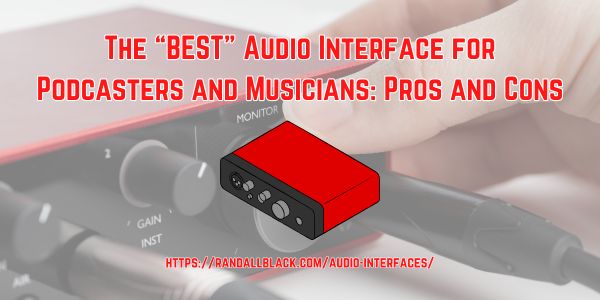Choosing the right audio interface can significantly impact your podcasting or music production workflow. Whether you’re a solo podcaster, a musician, or running a multi-person recording setup, selecting the right device is crucial. Below, we compare some of the top audio interfaces from Rode, PreSonus, Focusrite, MOTU, and other top brands, including advanced podcasting solutions like the Rodecaster Pro 2 and Mackie DLZ Creator.
1. Focusrite Scarlett 2i2 (4th Gen)
Pros:
- Affordable and widely used by beginners and professionals
- Solid preamps with Air mode for enhanced vocal clarity
- USB-C powered, making it highly portable
- Reliable driver support and low-latency performance
Cons:
- Limited to two inputs, restricting multi-person recordings
- No onboard DSP processing
2. PreSonus Studio 68c
Pros:
- Excellent audio quality with XMAX preamps
- Four combo inputs and solid I/O expansion
- USB-C connectivity with MIDI support
- Comes with PreSonus Studio One software
Cons:
- Slightly bulkier compared to similar interfaces
- Software can have a learning curve for new users
3. MOTU M4
Pros:
- Outstanding audio quality with ESS Sabre32 DAC
- LCD screen for real-time metering
- Ultra-low latency performance
- USB-C powered and bus-powered for portability
Cons:
- No onboard DSP effects or processing
- Software bundle is less extensive than competitors
4. Rode AI-1
Pros:
- Simple, compact, and rugged design
- Studio-quality preamp with low noise
- Plug-and-play functionality with USB-C
Cons:
- Single input limits flexibility
- Lacks MIDI support
5. Rodecaster Pro 2 (Advanced Podcasting Solution)
Pros:
- All-in-one solution for podcasters and streamers
- Onboard DSP, effects, and customizable sound pads
- Multi-channel recording via USB and microSD
- High-quality Revolution preamps
Cons:
- Pricey compared to traditional interfaces
- More features than necessary for solo users
6. Rodecaster Duo
Pros:
- Compact version of the Rodecaster Pro 2
- Same high-quality preamps and DSP effects
- Ideal for two-person podcasts or solo streamers
Cons:
- Fewer inputs than its bigger counterpart
- Still relatively expensive for an interface
7. Mackie DLZ Creator
Pros:
- Touchscreen interface for easy operation
- Great for podcasters with built-in effects and sound processing
- Multiple inputs with high-quality preamps
Cons:
- Larger footprint may not suit all setups
- Learning curve for those unfamiliar with digital mixers
8. Zoom Podtrak P8
Pros:
- Designed specifically for podcasting with multi-track recording
- Multiple XLR inputs with onboard sound pads and effects
- Battery-powered option for portability
Cons:
- Build quality is more plasticky compared to others
- Not as versatile for music production
Conclusion
If you’re a beginner or a solo musician, the Focusrite Scarlett 2i2 or MOTU M4 are excellent choices. If you need an all-in-one podcasting solution, the Rodecaster Pro 2 or Mackie DLZ Creator provide robust features. For a budget-friendly podcasting setup, the Zoom Podtrak P8 offers great multi-person recording capabilities.
Selecting the right audio interface depends on your specific needs, whether it’s professional music production, high-quality voice recording, or podcasting flexibility. Consider your setup and workflow to make the best choice!
